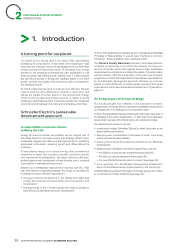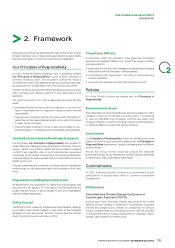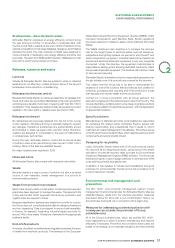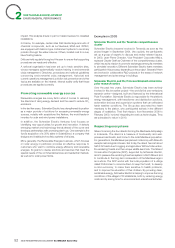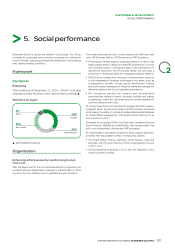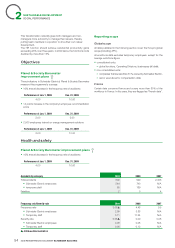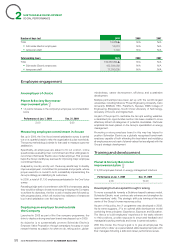APC 2009 Annual Report Download - page 50
Download and view the complete annual report
Please find page 50 of the 2009 APC annual report below. You can navigate through the pages in the report by either clicking on the pages listed below, or by using the keyword search tool below to find specific information within the annual report.
SUSTAINABLE DEVELOPMENT
2
2009 REGISTRATION DOCUMENT SCHNEIDER ELECTRIC48
ENVIRONMENTAL PERFORMANCE
Hazardous substances - 2009
The European RoHS (Reduction of Hazardous Substances) and REACH (Registration, Evaluation,
Authorisation and Restriction of Chemical Substances) directives
Managing and monitoring hazardous substances is a priority for the
European Commission, which has been a key driver in this area at the
global level. These substances can be a potential health risk or source
of pollution at the production, use and end-of-life stages.
Schneider Electric has included this issue in its environmental policy
for many years.
Schneider Electric takes the RoHS and REACH directives into account
in its internal action programmes . The directives are applied to products
made in Europe, with the goal of deploying them across Schneider
Electric’s entire global supply chain.
Two dedicated programmes have been set up to ensure compliance
and respond to customer expectations.
1. RoHS programme
The directive affects only a very small portion of Schneider
Electric’s lineup directly, but it impacts a larger share indirectly—
notably equipment integrated in products covered by the directive
and sold by other companies. In line with its commitment, the
Group brought all directly concerned and frequently integrated
products into compliance with the directive as of July1, 2006.
What’s more, the Group has gone far beyond the directive’s requirements
and decided to stop using these substances all together.
Although the RoHS Europe directive only applies to products sold in
Europe, Schneider Electric has decided to bring its entire lineup into
compliance worldwide.
This was the case for a very large percentage of product ranges
distributed worldwide in 2007 and 2008.
The programme was continued in 2009, and by the end of the year, only
a portion of the local lineup in a specifi c country and products to be
phased out in the short term or manufactured in very small quantities
were not RoHS-compliant.
This decision anticipated changes in other countries such as China,
where an equivalent regulation took effect on March1, 2007. South
Korea has applied its own RoHS directive since January1, 2008. New
regulations are expected in the years ahead, notably in the United States
in 2014.
The European RoHS directive is currently being updated, and the
European Parliament is scheduled to vote on the revised version
in 2010. Schneider Electric is involved in the discussions concerning the
fi nal text between the European Commission, the European Parliament
and industry representatives.
2. REACH programme
Schneider Electric launched a programme to ensure compliance with
the REACH directive in 2008.
The programme is designed to:
• ensure that substances used by Schneider Electric and its
subsidiaries are registered and authorised for the applications in
question, in accordance with REACH requirements. In early 2009,
Schneider Electric was informed that its suppliers had taken the
necessary measures to provide the European Chemicals Agency
with the required pre-registrations before December1, 2008. In
addition, Schneider Electric makes sure that the instructions provided
by suppliers of chemical substances to protect users’ health are
carefully followed, whether the substances in question are used in
the manufacturing process or integrated in the product itself;
• formalize the information to be provided to customers about the
presence of hazardous substances.
Work begun in 2008 was continued in 2009, and by the summer,
Schneider Electric had compiled a database with the necessary
information for a very large number of its standard products. This
information was put on line at the end of 2009.
Schneider Electric has played an active, recognised role in deploying
REACH. On several occasions, the Group has been asked to present
its methodology and results in European and international seminars.
REACH has also had a signifi cant impact on R&D:
• the new product development process now takes REACH and RoHS
into account. All new products must be designed to comply with
RoHS’s technical constraints and provide the necessary information
required by REACH;
• in liaison with other companies and outside laboratories, the Group’s
materials experts are working on substitutes that will certainly be
needed for certain chemical substances, taking care to avoid any
impact on product performance.
O n -line information for our partners
To make its partners’ work easier, Schneider Electric makes
documents available for downloading with REACH and/or RoHS
data for specifi c products. OEMs, for example, can consult a
spreadsheet with REACH data for different group products and use
it to calculate the data they must supply to their own customers.
The “Check a Product” application is now available at the
following addresses:
• www.rohs.schneider-electric.com
• www.reach.schneider-electric.com
• www.environ ment.schneider-electric.com
• and, of course, www.schneider-electric.com


